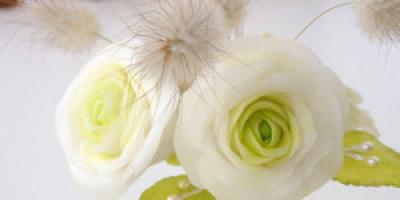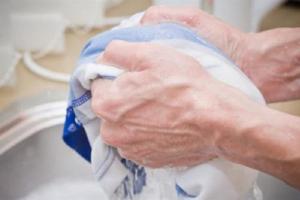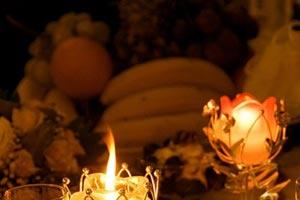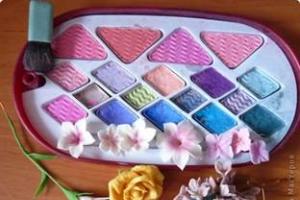
 Today, there are many forms of needlework with which you can create magnificent products and entire compositions. One of these methods is the technique of molding from cold porcelain. Naturally, it has nothing in common with the real mass, which is used in the industry for the manufacture of dishes. Many needlewomen prepare this composition on their own at home, and then they mold various figures, flowers and even whole paintings from it. And today we will tell you how to make cold porcelain with your own hands, as well as what crafts are made from it.
Today, there are many forms of needlework with which you can create magnificent products and entire compositions. One of these methods is the technique of molding from cold porcelain. Naturally, it has nothing in common with the real mass, which is used in the industry for the manufacture of dishes. Many needlewomen prepare this composition on their own at home, and then they mold various figures, flowers and even whole paintings from it. And today we will tell you how to make cold porcelain with your own hands, as well as what crafts are made from it.
The recipe for making cold porcelain is quite simple and involves the use of materials available to everyone. In addition, products (flowers, figurines, key chains), which are obtained from this mass, can be stored forever without fading and losing their beauty.
 There are many cooking options that result in cold porcelain at home. Some of them involve obtaining mass during the cooking process, others allow you to make modeling material in a simplified way. However, each recipe includes three main ingredients - PVA glue, starch, glycerin (Vaseline).
There are many cooking options that result in cold porcelain at home. Some of them involve obtaining mass during the cooking process, others allow you to make modeling material in a simplified way. However, each recipe includes three main ingredients - PVA glue, starch, glycerin (Vaseline).
Of the tools that are suitable for making cold porcelain with your own hands, you will need:
- Container for mixing components. To make the material without cooking, you can use a regular glass or plastic bowl. If the preparation of the mass will be carried out by heating on the stove, it is better to prepare a container with a non-stick coating.
- Tablespoon for mixing the mixture.
- A container with a lid and a plastic bag will be useful for storing the mass.
cooking options
It is quite simple to make material such as cold porcelain for modeling with your own hands. We suggest that you familiarize yourself with several options for the process.
Each recipe is available even to a beginner, as it reveals in detail the manufacturing technology.
Method number 1
 This recipe will tell you how to make cold porcelain with your own hands without boiling the mixture on the stove. The ingredients for its preparation are as follows:
This recipe will tell you how to make cold porcelain with your own hands without boiling the mixture on the stove. The ingredients for its preparation are as follows:
- 2 tbsp. spoons of PVA glue;
- 2 tbsp. l. starch;
- 1 st. l. vaseline;
- ? tsp soda.
First you need to place starch, soda, petroleum jelly and a couple of drops of glycerin in a container. Mix all ingredients and add glue. The resulting mixture must be kneaded to a homogeneous consistency, then knead well with your hands. If the mass sticks to the palms and fingers during this, lubricate it with a small amount of petroleum jelly (cream). Sprinkling the material with starch, you get ready-made cold porcelain.
 For storage, the mass must be wrapped in polyethylene and placed in a tightly closed container. You can put the tray with the material in the refrigerator. However, after 30 minutes it should be removed to change the polyethylene to dry. This procedure is necessary so that excess moisture does not accumulate in the composition.
For storage, the mass must be wrapped in polyethylene and placed in a tightly closed container. You can put the tray with the material in the refrigerator. However, after 30 minutes it should be removed to change the polyethylene to dry. This procedure is necessary so that excess moisture does not accumulate in the composition.
The advantages that this mass preparation recipe has are obvious. Firstly, it is the ease of manufacture and the components available to everyone. Secondly, the composition is non-toxic, even children can make crafts from such material (flowers, figurines, caskets, paintings, etc.).
Method number 2
 This recipe is also considered simple and involves the use of components that can be purchased at any store (pharmacy). However, the manufacturing process is carried out by boiling the mixture on the stove. Therefore, prepare the appropriate container and the following ingredients in advance:
This recipe is also considered simple and involves the use of components that can be purchased at any store (pharmacy). However, the manufacturing process is carried out by boiling the mixture on the stove. Therefore, prepare the appropriate container and the following ingredients in advance:
- 150 gr. PVA glue;
- 150 gr. starch (preferably corn);
- 25 gr. vaseline (you can take glycerin);
- 100 ml of warm water;
- 25 gr. hand creams.
To make cold porcelain with your own hands, you should take all the liquid ingredients from the list above and mix them. Then we put this composition in an appropriate container on a small fire and heat it up, stirring constantly. During the cooking process, add starch in small portions.
 The mixture must be constantly stirred so that it does not burn and turns into a homogeneous mass. At the beginning of cooking, it will look like cottage cheese, but at the end of the process, the consistency of the material should resemble mashed potatoes. Almost ready cold porcelain should be kneaded until it becomes a white mass, which is wrapped in a lump on a spoon.
The mixture must be constantly stirred so that it does not burn and turns into a homogeneous mass. At the beginning of cooking, it will look like cottage cheese, but at the end of the process, the consistency of the material should resemble mashed potatoes. Almost ready cold porcelain should be kneaded until it becomes a white mass, which is wrapped in a lump on a spoon.
After that, you can remove the container from the stove, and put the material on a kitchen towel. It must be clean and pre-moistened. The mass must be wrapped in a towel and kneaded with your hands until it cools completely, after which you can remove it from the towel and continue the procedure.
To prevent the material from sticking to your hands, it must be periodically sprinkled with starch.
Knead the composition until the lump becomes homogeneous, plastic and stops sticking to the palms and fingers. Now do-it-yourself cold porcelain can be considered ready and crafts can be made from it (paintings, flowers, etc.). It should be stored in the same way as described earlier.
Method number 3
 This recipe differs from those described above not only in the composition of the necessary components, but also in the cooking process (without cooking on the stove). And before starting the process, you should prepare a glass container that can be put in the microwave, and the following components:
This recipe differs from those described above not only in the composition of the necessary components, but also in the cooking process (without cooking on the stove). And before starting the process, you should prepare a glass container that can be put in the microwave, and the following components:
- two 200 gr. cups of cornmeal;
- two 200 gr. cups of PVA glue;
- 30 ml lemon juice;
- 60-70 gr. glycerin (vaseline);
- 30 gr. non-greasy white hand cream.
 All components, except for the cream, are mixed in a prepared container with a wooden spoon. After that, place the mixture in the container in the microwave, set to full power, for three minutes. After every 60 seconds, the composition must be removed and mixed. If the power of the device is small, the process of such cooking can be extended up to 5 minutes.
All components, except for the cream, are mixed in a prepared container with a wooden spoon. After that, place the mixture in the container in the microwave, set to full power, for three minutes. After every 60 seconds, the composition must be removed and mixed. If the power of the device is small, the process of such cooking can be extended up to 5 minutes.
Thus, you will be able to make a homogeneous mass, which should be thoroughly kneaded. To do this, the mixture must be laid out on a surface previously lubricated with a non-greasy hand cream. Then we knead it with our hands as long as possible.
It is worth noting that the longer you manage to knead the material with your own hands, the more plastic the cold porcelain will become. Accordingly, crafts (flowers, figures, etc.) will be even, smooth and beautiful.
How can you get a colored mass?
 Do-it-yourself cold porcelain can also be painted in several ways. And each recipe may also differ in the method of dyeing and the type of paints used.
Do-it-yourself cold porcelain can also be painted in several ways. And each recipe may also differ in the method of dyeing and the type of paints used.
In order for crafts (paintings, caskets, flowers, etc. products) to acquire a bright saturated color, you can take paints: oil, acrylic, food, as well as gouache, watercolor. It is necessary to add them to the material when kneading (after cooking). So you get a mass with a uniform shade.
You can also paint ready-made crafts that you can make from ready-made cold porcelain. Products with this method of staining acquire a rich color, close to natural.
To do this, take a frozen figure, apply dry powdered food paint to it with a brush. After that, you need to hold it for several minutes over a boiling kettle.
Flowers and other items made of cold porcelain dry within 1-7 days. The drying process can be accelerated by placing the products in the oven, baking them at the lowest temperature.
Evgenia Smirnova
To send light into the depths of the human heart - this is the purpose of the artist
Art activities involve working with various kinds of materials. When sculpting figures, for example, in addition to clay, you can use cold porcelain, which is much easier to deal with. This plastic composition is more delicate, which ensures that the feeling of weightlessness is preserved in finished crafts. Often, flowers and small details that require careful study are made from cold porcelain.
What is cold porcelain

The main ingredients, without which it is difficult to imagine the preparation of this type of porcelain, have long been considered glycerin, corn starch, PVA glue and oil. Modern recipes undergo changes in composition. A homogeneous composition for modeling was invented at the beginning of the last century in distant Argentina. Initially, it was created for the manufacture of small figurines with many details. Art molding from cold porcelain is popular among adults and children because of the extreme ease of working with it.
How to make cold porcelain with your own hands
The convenience of soft pliable mixtures for creativity lies in the possibility of preparing them at home. You can make cold porcelain with your own hands without much effort and money. The step-by-step instructions vary but mostly contain the same steps and ingredients. The recipe for cold porcelain at home may contain such a step as cooking, or it may do without it. There are ways to cook even in the microwave, but they are more time-consuming.
Training master class for beginners
It will take time to learn how to sculpt beautiful figures, but even beginners who have never sculpted handicrafts can easily prepare cold porcelain. The mass is prepared from the following components:
- corn starch;
- baking soda;
- water;
- vegetable oil.
A more common cooking method looks like this:
- Take the same amount of soda and starch, move between them in a saucepan.
- Gradually add water to the dry ingredients. The proportions should be 2:1.
- Pour in some oil.
- Put the composition on a gentle fire and, constantly kneading, bring to a thickening. Porcelain should be of a dense consistency.
- After turning off the stove, cover the saucepan with porcelain, pre-moistened with a towel.
- When the temperature is right, pat the material with your hands to ensure uniformity.
Recipe for cold porcelain without cooking

To cook or not to cook? That is the question! Craftswomen who prepare cold porcelain with their own hands are divided into two categories: the first for cooking, and the second against it. There are practically no differences in consistency and properties. Cold porcelain without cooking is just as plastic and easy to make. The required ingredients include:
- starch - 2 tbsp. l.;
- vaseline - 1 tbsp. l.;
- baking soda;
- PVA glue.
The algorithm is:
- Take a dry dish and pour starch into it. You can take corn or potatoes.
- After slightly melting the vaseline in a water bath, add it to the dry ingredient.
- Sprinkle some soda. Thoroughly mix the future porcelain to avoid the formation of lumps.
- Next, add glue by a teaspoon to achieve softness of the composition.
- Before work, lubricate the material washed to homogeneity with petroleum jelly.
How to cook from potato starch on the stove

Potato starch is a more familiar ingredient for culinary experts than its corn counterpart. It can be found in almost every home, so cooking porcelain from it may be easier in terms of availability. If you plan to create light elements, such as rose petals, it is better to forego potato starch, since the characteristic of the product is a grayish color. A simple classic way involves cooking on the stove. List of components:
- potato starch - 180 g;
- glue - 180 ml;
- lemon juice - 1 tbsp. l.;
- glycerin - 1 tbsp. l.;
- vaseline - 1 tbsp. l.
Actions are as follows:
- Sequentially combine all the ingredients in a small saucepan. The mass will turn out to be liquid, it must be mixed to a uniform consistency before being cooked through heat treatment.
- The dishes with the solution are placed on the weakest fire and the composition is stirred. Readiness is determined by the mass adhering to the spoon.
- The cooled material is kneaded with hands smeared with cream for at least 5 minutes.
How to color the resulting mass

Cold porcelain made at home requires staining. Food colorings, pigments and acrylic paints are used to impart color to the mass. The first two dyes are used when cooking porcelain, adding to the composition along with the main components. In this case, you will need to prepare several balls of porcelain mass in order to endow each with a different color. Acrylic paints are used when the product is dry and just needs to be painted. This option is a little more convenient, more practical and takes less time.
How to do crafts
Cold porcelain is a material that is often mentioned in master classes for making flowers. You can blind them without using special tools, with one hand, but the best result can be achieved with the help of molds. In addition to them, delicate flowers are made using plastic spoons. The plastic mass is laid and rolled along the deepening of the spoon, and then several of these elements are assembled into a flower, for example, a tulip. You can use different tools, this creative process is limited only by imagination.
How to dry the finished product

Drying the finished craft is an important step in all work with cold porcelain. There are cases when, when drying the finished product, the material cracks, leaving ugly grooves. How to properly dry the craft? This is done at room temperature, at least during the day. It is very important to turn the product over if it is lying on one of the sides, and not in an upright position. To speed up the process, some needlewomen slightly heat the oven, and then, turning it off, briefly place the craft there.
Porcelain products have always been admired. Now you can model cold porcelain crafts yourself at home. And for the preparation of the material, we need quite affordable components: glue, food starch, liquid glycerin and an oil base.
Products from cold porcelain: manufacturing features
Recently, this type of applied art is gaining great popularity. You can model a variety of cold porcelain crafts with your own hands at your leisure. The main thing is to properly prepare the consumables and observe some design features of the craft:
- to prepare cold porcelain, use PVA glue (2/3 tbsp), table starch (1 tbsp), liquid glycerin (1 tsp) and water (1/2 tbsp.);
- all components in the indicated proportions are mixed in a container and heated until the mass thickens;
- the heated mass must first be laid out on a towel or napkin moistened with ice water;
- cold porcelain should be kneaded with your hands, the surface is sprinkled with table starch;
- to make the mixture elastic, before kneading, hands must be greased with a fat cream;
- cold porcelain remains elastic for two days;
- to give it the desired shade, you can use any food coloring;
- to form blanks, you need to use templates;
- each detail should be thoroughly dried so that the craft retains its shape;
- if you paint any elements of the craft separately, be sure to hold them over the steam so that the dye is evenly distributed over the surface.
Crafts for beginners
If you are just interested in this direction of needlework and want to make real masterpieces of art from cold porcelain, start with simple crafts. For example, make a hand-made gift for a loved one. As you master all aspects of cold porcelain sculpting, you will be able to complicate the task and design exquisite models of various figures.
Learning to make porcelain peonies
Let's first try to make an original peony. By the way, you can make one voluminous flower or show your imagination and create a beautiful bouquet. To do this, you need to purchase a number of floral attributes, in particular, teip tape, boutonniere bases, multi-colored ribbons.

Necessary materials:
- porcelain cold pink and green;
- scissors;
- flower stem sticks;
- template forms.
Step by step description of the process:
- If you don’t have pink porcelain on hand, you can mix white and red.

- Now we divide the cold pink porcelain into 20 small pieces and 12 large ones.

- With your fingers or with the help of a teaspoon, we begin to model the petals.

- Be sure to press them to make a bulge. We should get 20 small and 12 large petals.
- We glue all the small petals together in pairs in a row. In total, we should get 10 paired petals.

- Next, we place all the blanks with the curved side towards us and begin to form a fan.
- We connect all paired petals with each other, fixing them slightly overlapping.

- We twist the resulting blank into a flower in a spiral, slightly pressing the cold porcelain.

- We also overlap large petals around the circumference of the flower. The convex side should be outside.

- We put our flower aside for the time being and proceed to modeling the leaves.
- We lay out cold porcelain of green or salad color on a special template and press it so that scars form.

- Gently bend the leaf with your fingers so that it acquires a slightly pointed shape.

- Next, we string the flower blank onto a floristic stick. In this form, we leave the flower to dry for a day.

- When the porcelain hardens well, add leaves to our flower, decorate the stem with ribbons and form a bouquet.
- Here is such an original peony bouquet you can get.
Exquisite poppies: master class
As you already understood, porcelain must be prepared by heat treatment. But you can choose a simpler option and make cold porcelain without heat treatment with your own hands. Crafts without cooking from such material do not differ in their texture and elasticity.
All you need is to take food starch and petroleum jelly and grind them until a homogeneous mixture is formed. Then it is necessary to add oil glycerin to the resulting mass and spread PVA glue in small portions, kneading cold porcelain. Let's try to prepare such material and make an original poppy flower out of it.

Necessary materials:
- porcelain cold red, black and green;
- scissors;
- foil;
- toothpick;
- rolling pin
Step by step description of the process:

Recently, the popularity of this type of creativity, like porcelain modeling, is increasing every day. Both children and adults do this type of needlework. You can make beautiful figurines, jewelry, toys from cold porcelain. If you decide to do this type of handmade, you will need porcelain for modeling and special tools. And beginner needlewomen will also come to the aid of master classes by experienced craftswomen.
Cold Porcelain Recipes
Cold porcelain sculpting kits are available at art supply stores. However, such material can be made independently, armed with simple recipes.
First of all, to get cold porcelain for modeling, you will need the following tools and materials:
- Small container for mixing ingredients. When choosing methods that do not require cooking for porcelain, glass and plastic dishes are suitable, but if you will cook the components, find a metal container, preferably with a non-stick coating.
- Spoon for mixing all the components of the mass for modeling.
- A plastic container with a lid or a plastic bag in which the finished mass will be stored.
Each of the recipes requires the mandatory use of only three components- PVA glue, starch and glycerin or petroleum jelly. Some recipes also use additional ingredients. Take advantage of these affordable cold porcelain recipes for modeling.
Method number 1. Cooking on the stove
To prepare the mass according to this recipe, you will need the following ingredients:
- a glass of PVA glue;
- a glass of starch;
- 2 tbsp. l. glycerin;
- 1 st. l. baby cream.
Cooking:


This mass hardens very quickly, immediately it will look like cottage cheese, but soon a large lump will form, resembling a dough.

Put the mass on the table, smeared with cream, and let it cool a little.

When it cools, start kneading until you get a homogeneous mass, like the modeling dough that children love so much.
Method number 2
You will need these components:
- 2 cups cornstarch;
- 2 cups of PVA glue;
- 3 art. l. glycerin;
- 3 art. l. white fat body cream or liquid petroleum jelly;
- 3 art. l. baby oil for the body;
- 1 tsp citric acid.
Follow this action plan:
- Mix all ingredients except starch in a metal bowl.
- Put on a slow fire and cook, stirring constantly, until one large ball forms.
- Take it out of the pan, put it on the table, cover with a towel and let it cool slightly.
- Then stir until the mass is smooth and elastic.
Method number 3. Cold porcelain without cooking
Required Ingredients:
- starch - 1 tbsp.;
- 1 st. dry chalk;
- PVA glue - 2 tbsp.;
- liquid vaseline - 6 tbsp. l.;
- formalin - 6 drops.
Prepare cold porcelain in this way:

If you need colored porcelain, at the stage of mixing all the components, add paints - oil or acrylic, or mix edible paints with vegetable oil and add to the rest of the ingredients.
With this type of needlework, one cannot do without such tools for sculpting from cold porcelain:
- rolling pin;
- scissors;
- tweezers, wire cutters;
- toothpicks;
- brushes, paints;
- gloves;
- cutting board;
- wet wipes;
- thin wire or glue for connecting product parts.
Sculpting peony flowers from cold porcelain: the process of creating from a ready-made set
This beginner's cold porcelain workshop will allow you to create beautiful compositions easily and with pleasure. Most often, various flowers are made from cold porcelain, as flower arrangements and decorations consist of them. You can buy a ready-made kit for sculpting peonies, roses, orchids from cold porcelain in a needlework store, but you can create all the flower elements yourself.
Cold porcelain for sculpting flowers must first be painted in the desired color, and you can begin the process of creating an original craft:



Such lush flowers can be made from light pink, burgundy, yellow and white clay. If you are creating a flower arrangement, and do not use peonies for decorations, wrap a thick wire that acts as a stem with green cold porcelain and form 3 leaves.
Master class on modeling porcelain dolls
Porcelain dolls- good decorations for modern interiors, such products can also be presented to your friends or loved ones. Use this master class for sculpting porcelain dolls for beginners:

The porcelain doll is ready, it remains to dress her in a beautiful fluffy dress! Elements of clothing, eyelashes and artificial hair can be found in needlework stores that sell everything for decorative molding from cold porcelain.
Sculpting a bonsai tree trunk from cold porcelain
To make a decorative Bonsai tree that will decorate the interior of your home, in addition to the main material - polymer clay, you will need:
- thick wire;
- medium-sized expanded clay;
- black and brown gouache;
- gray and brown shadows for tinting the trunk;
- gypsum;
- capacity (pot) for a bonsai tree.
The process of manufacturing an interior decor element:

Rules for drying products from cold porcelain
When a polymer clay product is ready, it is important to dry it properly, otherwise all the work may be in vain. The most common problem that beginner needlewomen face when working with cold porcelain is the formation of cracks in the material.
To prevent this from happening, it is important to follow these drying rules:
- Dry the product only at room temperature.
- The finished product must be left alone for at least a day.
- It is necessary to periodically turn the product over if it is more located on one side.
Experienced needlewomen, in order to speed up the drying process of the finished figurine, heat the oven, and when it cools down a bit, place the product in it for a couple of minutes.
There are no clear boundaries in creativity, everyone chooses a hobby according to their desire and abilities. If there is a predisposition to modeling, then you can stop at cold porcelain compositions. For many, this is something new, since the name itself sounds unusual. However, it is much more convenient to work with such material than with plasticine or clay. It is more plastic more accessible and cheaper. This type of applied modeling is becoming more and more popular. And the resulting products are admired for their lightness and sophistication.
Cold material is easy to make at home. This will require a standard set of ingredients: glycerin, glue, oil, starch. The composition was invented at the beginning of the 20th century in Argentina. Our country also loved him. Only recently have new, improved, cooking options begun to appear. The mass, initially soft, later hardens.
For what kind of work can cold porcelain be used? You can make New Year's toys from it - this year the pig was a favorite model - and bouquets of flowers, large paintings and small pictures, wall panels and figurines, even decorative dishes can be made from this wonderful material. In addition, cold porcelain is increasingly being used to make jewelry - cool brooches are very well made from it.
Master class on making cold porcelain at home
Before starting the master class, aimed at teaching the modeling of all kinds of porcelain crafts, we are preparing the material. The main thing is to observe the technology and values. The sequence of actions is as follows:
Gallery: cold porcelain crafts (25 photos)


























Cold porcelain jewelry, a step-by-step master class
Let's try with our own hands make a ring with roses. Required list of consumables:
- cold porcelain;
- adhesive composition;
- toothpicks;
- foam or any sponge composite.
The first thing we start with is rolling the ball. We pull it out in the form of a drop, and stick a toothpick into the lower part. This will turn out to be a blank, with which we will continue to work. We make such details in the amount that there will be roses. So that they have time to get stronger, we make them in advance.
Let's move on to the petals. And also, we roll a spherical shape, flatten it between the palms, and we get a petal. We model the edge area at the discretion, it can be wavy or even. The only thing is that the edge should be an order of magnitude thinner than the central part.
To fix it on the core, glue is pre-applied and pressed effortlessly. Acting in this way, we increase the flower head to the required size. Do not forget to bend the petals outward a little to get an openwork border.
After a daily exposure, the rose will finally harden. We fix the resulting composition on any ring with epoxy glue. Cold porcelain jewelry looks unusual and stylish, giving additional charm. When falling, they will have nothing. Cold porcelain does not break and is difficult to break.
Storage recommendations for cold porcelain items
 Despite the availability and versatility of the material, it requires certain conditions of detention. Close proximity to water and direct exposure to sunlight is unacceptable. It should be remembered that this is polymer clay, which tends to become limp when damp. And from excessive lighting, loses its color. Therefore, it is better to place ceramic bouquets away from the sun. Window sills are excluded.
Despite the availability and versatility of the material, it requires certain conditions of detention. Close proximity to water and direct exposure to sunlight is unacceptable. It should be remembered that this is polymer clay, which tends to become limp when damp. And from excessive lighting, loses its color. Therefore, it is better to place ceramic bouquets away from the sun. Window sills are excluded.
In a room with such products, it is necessary to observe the optimal temperature regime. In extreme cold, moisture particles inside crystallize, which leads to the destruction of the structure. Drying out in the heat, which causes damage to the external exterior.
Some put varnish on the surface. This technique helps to provide protection from any external factors.
What can be made from cold porcelain
 The range of crafts is huge, it's up to imagination and practical skills. It is better for beginners to master science from simpler elements, making separate notes for better assimilation. Little fashionistas can be advised on various jewelry: rings, hairpins, brooches, etc. . This kind of decoration look quite original and extraordinary. It will be interesting if small children are involved in the process. Joint work on cartoon characters will bring a lot of joy. And the heroes made with their own hands will be a wonderful decoration for a children's interior.
The range of crafts is huge, it's up to imagination and practical skills. It is better for beginners to master science from simpler elements, making separate notes for better assimilation. Little fashionistas can be advised on various jewelry: rings, hairpins, brooches, etc. . This kind of decoration look quite original and extraordinary. It will be interesting if small children are involved in the process. Joint work on cartoon characters will bring a lot of joy. And the heroes made with their own hands will be a wonderful decoration for a children's interior.








